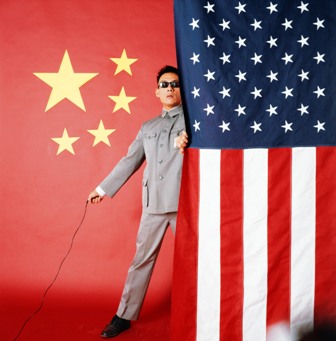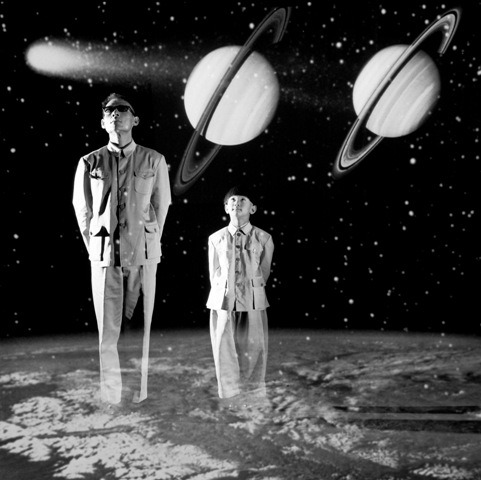By Jerome Langston
Whether he is staring at the camera stoically, wearing mirrored sunglasses,
or laughing with Keith Haring, Kenny Scharf, or Ann Magnuson at Danceteria,
Tseng embodies the essence of the 1980s; not only its extravagant social life
but also its attention to issues of identity and race.
― Amy Brandt, the Chrysler Museum’s McKinnon Curator of Modern and Contemporary Art, from Tseng Kwong Chi: Performing for the Camera
There is a palpable heaviness when viewing the wide-ranging, 75 or so photographic works of ‘80s art-scene bon vivant and underappreciated contemporary photographer, Tseng Kwong Chi, during a Tuesday morning press tour of the artist’s striking exhibit, which officially opens a couple days later at the Chrysler Museum of Art. Tseng Kwong Chi: Performing for the Camera, represents not only the first major museum retrospective of the photographer who was often known as simply “Keith Haring’s photographer,” but it’s also the final curatorial work of the late Amy Brandt, the museum’s McKinnon Curator of Modern and Contemporary Art, who passed away this past May at the untimely age of 37. Though still very young as a curator, Brandt had already garnered acclaim for her work on previous Chrysler shows, including 2012’s 30 Americans, which garnered national attention, and was regarded as the museum’s largest exhibit up to that point.
It was during the 30 Americans roll-out that I first met Brandt, who provided me with a tour of the remarkable works by the African-American artists featured in the huge exhibit, which occupied multiple spaces throughout the museum. Amy was lovely and deeply passionate about art, while also being generous with her time. Her contextualization of the diverse array of works featured in that show, from Rashid Johnson to Kehinde Wiley, was nothing short of exceptional. I discuss this with Museum Director, Erik Neil, in his office a couple weeks later. He acknowledges that Amy’s passing has been, understandably, difficult to cope with for her Chrysler colleagues.
“Here’s a young woman, with a young family, who was so vibrant and producing so much―who gets this really rare illness, and is just taken away from us way too soon,” Neil says. The exhibit, which is co-organized with the Grey Art Gallery of New York University, and has already received positive coverage from prestigious publications like the New York Times and Paper magazine for its debut mounting at Grey, is presented in Amy’s memory. Following its stint here at the Chrysler, it will travel to the Tufts University Art Gallery, and then to the Block Gallery of Northwestern University. Brandt conceived of, and curated the exhibition, as well as authored the gorgeous hard-cover art-book that accompanies it. “She worked very hard on this. This was absolutely a labor of love.”
If love is indeed in the details, as Saint Oprah likes to say, then this show is quite full of it. All of Tseng’s notable pieces are included in this retrospective, and mounted perfectly to reflect his growth as an artist and quirky sort of photojournalist, contextualized properly via the multiple series groupings that defined his professional oeuvre. So of course there’s his famous East Meets West and Expeditionary series, which features stand-out works including “Niagara Falls, New York. 1984” and “New York, New York (Brooklyn Bridge), 1979.” But then there’s also his sardonic humor on display via his Moral Majority series, as well as his love of celebrity and interest in high culture dynamics, through the many works that populate his acclaimed Costumes at the Met series, and his Portraits of the Artist series. And to celebrate the show, besides the huge opening that included a deejay and after-party at Norfolk’s trendy Work │ Release, the museum’s young creatives launched a Tseng Kwong Chi inspired selfie photo contest for the Chrysler’s Instagram page.
Viewing the artist’s work, including the large piece, “East Meets West Manifesto, 1983,” which greets you upon arrival to the exhibit space, it’s clear that Tseng was quite ahead of time, even as much of his photographs evoke a kind of eighties New York art-scene nostalgia. His self-portraiture, for example, really sits comfortably as a forbearer of the current selfie art movement. Additionally, the nature of his own art circle celebrity, appearing at New York art events, clubs and other high-end social gatherings, wearing his now famous Mao suit, fits into the “now culture,” where personality and visual persona alone, can earn one a high level of fame. Now of course the Hong Kong born Tseng, who worked with and/or partied with such eighties era icons, as Madonna, Jean-Michel Basquiat, Keith Haring and Andy Warhol, before succumbing to Aids in 1990 at the young age of 39, was very aware of the fickle and oft times disturbing nature of celebrity and social status. Much of his work essentially lampoons it, while also making a number of striking social and political statements―some clear, others subtle.
“He really develops as an independent artist with his own unique vision, when he gets to New York,” explains Seth Feman, the Chrysler’s Manager of Interpretation, during a recent visit to the museum. In addition to Amy, Seth also worked with Muna Tseng, Tseng’s younger sister and estate executor, on the mounting of this show. “A lot of the objects on view are on loan from her,” he notes.
“He was always very judicious about the kinds of pictures he was taking,” Seth later explains. “It’s something that we don’t think about a lot because we have digital cameras.” That’s quite sad, but very true. I then ask him if Tseng was aware that his work was, in many regards, satirical. Seth answers in the affirmative. “He’s always thinking about what the image does.”
Tseng Kwong Chi
Performing for the Camera
Through December 13
Chrysler Museum of Art
Chrysler.org





